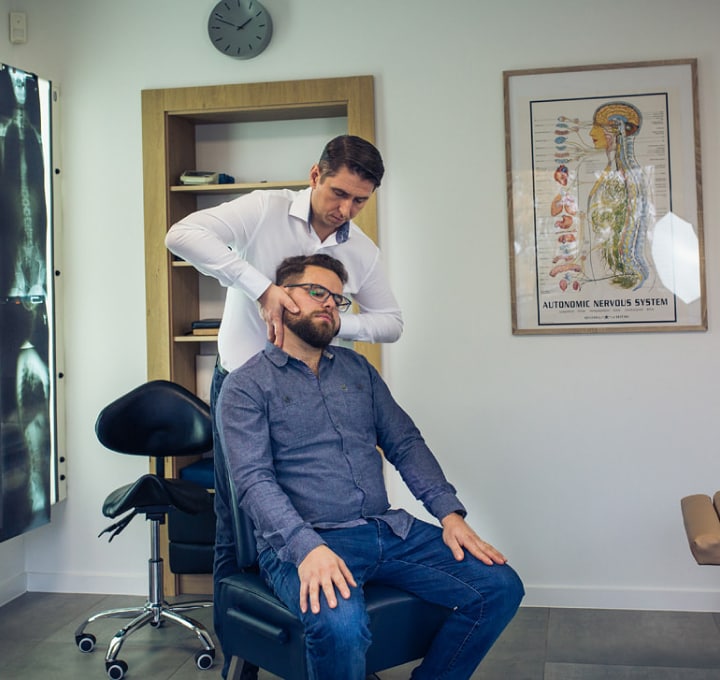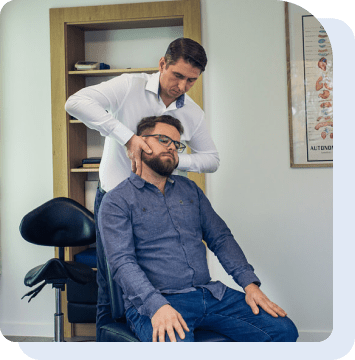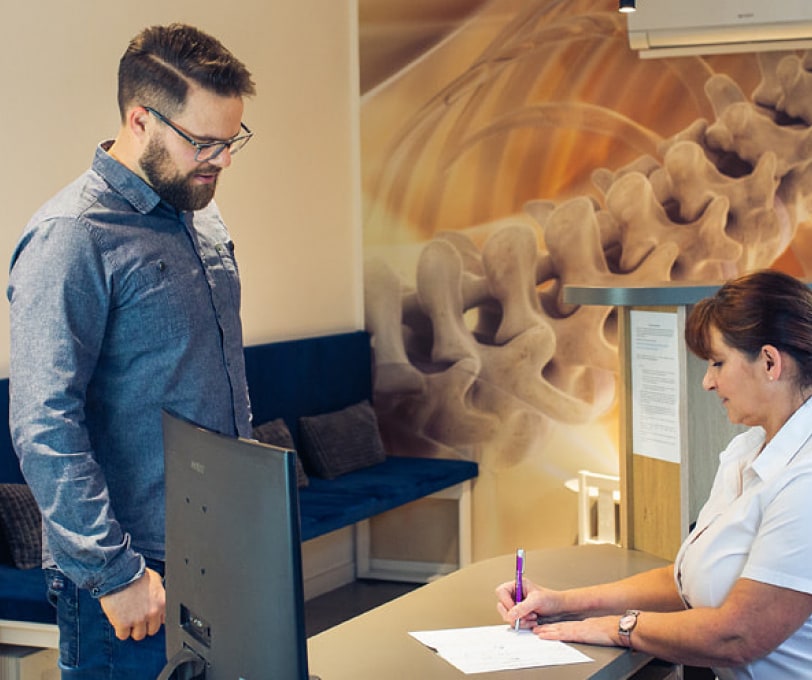Therapy Chiropractic is a natural way to take care of your health
The aim of chiropractic procedures is to remove abnormalities in the musculoskeletal and nervous systems through gentle mobilization with an impulse (high velocity low amplitude – HVLA) of the spine and peripheral joints.


licensed manual therapist Dr Tomasz Kościuk
Dr. Tomasz Kościuk graduated from a two-year Medical School of Therapeutic Massage in Krakow, he is a graduate of five-year studies in physiotherapy at the Krakow Academy of Physical Education, where he obtained a master’s degree.
As a research and teaching employee of the Department of Anthropology and Human Anatomy, he dealt with the epidemiology of body posture defects in children and adolescents for several years.
Modern forms of therapy of disorders within the human musculoskeletal system
Full health and well-being is dependent on the nervous system functioning optimally, because it is the superior system that controls the others. The spine is made of vertebrae and discs, if they are displaced, there is pressure on the nerves, inflammation, and therefore pain.
Physiotherapy, manual therapy and chiropractic are modern methods of therapy, thanks to which it is possible to restore the proper functioning of the musculoskeletal system, and often avoid the need to undergo surgery. Getting rid of persistent pain helps you enjoy life without any obstacles.

Proven methods in the treatment of reversible musculoskeletal disorders
Worldwide, three member states of the professions: physiotherapists, chiropractors, osteopaths are the appropriate methods of dividing the functions of the musculoskeletal system using a natural form of therapy (manual therapy, physical therapy and others).
In Poland, the method of manual therapy or chiropractic is not as common as in other countries, but it is gradually gaining recognition in medical circles.
Often the patient has a choice: endure the pain or undergo spine surgery or take advantage of the possibilities of chiropractic methods.

Problems When is help available?
-
allergies
-
sterility
-
ear and eye pain
-
asthma
-
knee pain
-
sinus problems
-
bedwetting
-
lumbar and back pain
-
sleep disorders
-
osteoarthritis
-
middle back pain
-
conditions after spinal fractures
-
elbow pain (golfer's elbow, tennis elbow)
-
migraines
-
post-surgery conditions
-
fibromyalgia
-
neck and neck pain
-
sports injuries
-
headaches
-
a feeling of numbness or prickling
-
slight displacement of the vertebrae
-
chest burning
-
nerve compression (sciatica, femoral, shoulder)
-
subluxations
-
intervertebral disc herniation
-
scoliosis
-
nausea and dizziness
-
hip pain
-
shoulder pain
-
whiplash traffic injuries
FAQ Frequently Asked Questions
-
What should you expect on your first visit?
During the first visit, an initial interview will be conducted, physical examination (assessment of the condition of the spine, examination of body posture, measurement of the length of the lower limbs, examination of the range of motion in the joints, their asymmetry, basic physiotherapy examination including provocative tests, general neurological examination), photo analysis will take place X-ray, MRI or CT of the spine, instrumental examination with a neuroscope, and then a preliminary plan of therapy will be presented. Based on the information obtained in this way about the condition of the patient’s spine, the first manual therapy treatment will be performed.
-
How many treatments are needed for the pain to subside?
The number of treatments that need to be performed to improve depends on the degree of damage and the type of vertebral displacement, the type of dysfunction causing the pain – whether it is a functional problem or a structural disorder (e.g. bone protrusions, torn ligaments), it is also important how long the problem has existed – a week or twenty-five years. Sometimes the effects are visible immediately, in other cases the therapy includes a larger number of treatments, especially in the case of chronic problems.
-
Is it safe to undergo treatments?
Is manual therapy safe? Yes, but under certain conditions. Safety depends primarily on who performs the procedure, what education and experience they have in this field, what procedures, methods and techniques they use. An educated and experienced specialist can effectively help where pharmacological methods work only by masking the problem, removing only pain – a symptom, not the cause of dysfunction. All over the world – in Europe, America, Africa and Australia – three liberal professions are educated at the academic level: masters in physiotherapy, chiropractic and osteopathy. It is better to avoid folk medicine men, “grandmothers”, homegrown “chiropractors” who have learned one trick “for everything” and want to practice manipulative procedures on the patient and other unqualified people offering their services in the field of manual therapy. The risk is too great – our health and well-being are at stake.
The methods proposed in the office are proven and safe, adapted to various types of musculoskeletal dysfunction. Treatments are performed in accordance with the generally understood procedures of chiropractic examination and treatment. At the same time, they do not rely on manipulation related to joint rotations, which is sometimes the cause of micro-damage, but on mobilization with an impulse (called adjustments). The therapist has the appropriate education and many years of experience in this field. In addition, the techniques used during the procedure are always selected individually, depending on the problem and the age of the patient.
-
What to bring for the first visit?
X-ray (X-ray) or magnetic resonance imaging (MRI) or computed tomography (CT) scan of the spine or other additional tests, if any, but not older than ten years ago. If the patient does not have any test results, during the first visit he or she will be informed about the need to perform appropriate tests, depending on the patient’s problem (with instructions on how to take, for example, an X-ray and which section of the spine needs to be X-rayed). It is worth putting on comfortable clothes (preferably elastic pants and a cotton blouse).
-
How can you prevent back pain from getting worse?
You should follow the individual recommendations of a manual therapist, as well as regularly use appropriate therapeutic gymnastics and spend your free time actively. Periodic prophylactic use of treatments brings good results, which means taking care of the condition of the spine before serious pain ailments occur. The fight against bad habits is also the basis of well-being – taking care of the correct position of the spine in a sitting position, avoiding supporting the head with one hand while reading a book or crossing legs. It is also important to allocate the right amount of time for sleep, a healthy diet that ensures adequate hydration and nutrition of the body, which affects the condition of the joints and discs. The type of footwear you wear is also important; similarly, avoiding overloading the joints, which is common during intensive work in the home garden or when practicing sports in which the body works on one side.





























